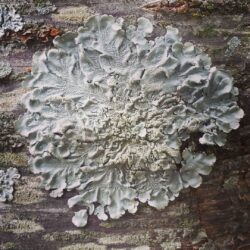By Hannah Hunt
 If you have spent time at Bernheim Arboretum and Research forest then you’ve likely seen lichens growing on trees, benches, or rocks. Lichens are abundant at Bernheim and this is good news because lichens are great bio-indicators of surrounding air quality and pollution levels. In urban areas where sulfur dioxide levels are high, lichens may be totally absent. When the air is clean, lichens become more diverse and prevalent.
If you have spent time at Bernheim Arboretum and Research forest then you’ve likely seen lichens growing on trees, benches, or rocks. Lichens are abundant at Bernheim and this is good news because lichens are great bio-indicators of surrounding air quality and pollution levels. In urban areas where sulfur dioxide levels are high, lichens may be totally absent. When the air is clean, lichens become more diverse and prevalent.
What are Lichens?
Lichens are formed by a complex relationship between fungi, algae, and/or cyanobacteria.
The fungus portion gives the lichen its shape and fruiting body characteristics while the algal portion photosynthesizes and provides food for the fungus, allowing the lichen to grow and spread. While they are made up of both a fungal and algal component, lichens are considered to be their own organism with unique properties. While they do have some plant-like characteristics, lichens are not plants. There are about 20,000 known species of lichens comprised of many different sizes, colors, and forms.
Lichen Size, Shape, Color
 Taxonomically, lichens are classified as fungi but are commonly grouped into four categories: leprose, crustose, foliose, and fruiticose. Lichens come in many colors. Some lichens have special pigments, such as yellow usnic acid, which can give the lichen a red, orange, yellow, or brown color. Lichens without special pigments are usually bright green or olive gray.
Taxonomically, lichens are classified as fungi but are commonly grouped into four categories: leprose, crustose, foliose, and fruiticose. Lichens come in many colors. Some lichens have special pigments, such as yellow usnic acid, which can give the lichen a red, orange, yellow, or brown color. Lichens without special pigments are usually bright green or olive gray.
Which lichens can I see at Bernheim?
 Bernheim’s unique geography provides a range of habitats, from upland ridges to moist bottomland, which are perfect for a variety of lichen species. In 2013, Douglas Ladd conducted a lichen inventory at Bernheim, the first of its kind in our region of Kentucky, and found over 200 taxa of lichens present at Bernheim. While this number might seem high, it is slightly lower than we might expect for a protected block of forest—around 16,000 acres at the time. This may be contributed to the past land uses of the forest, which included heavy grazing, timber removal, iron ore production, and salt mining. Despite this minor setback, many positive discoveries were made. Of the 222 lichens discovered, one is known for its sensitivity to acid rain and five are considered to be rare.
Bernheim’s unique geography provides a range of habitats, from upland ridges to moist bottomland, which are perfect for a variety of lichen species. In 2013, Douglas Ladd conducted a lichen inventory at Bernheim, the first of its kind in our region of Kentucky, and found over 200 taxa of lichens present at Bernheim. While this number might seem high, it is slightly lower than we might expect for a protected block of forest—around 16,000 acres at the time. This may be contributed to the past land uses of the forest, which included heavy grazing, timber removal, iron ore production, and salt mining. Despite this minor setback, many positive discoveries were made. Of the 222 lichens discovered, one is known for its sensitivity to acid rain and five are considered to be rare.
Be sure to keep your eyes peeled for lichens while strolling in the arboretum or hiking the trails but, as always, please follow Leave No Trace practices. Take nothing but photographs, leave nothing but footprints!

